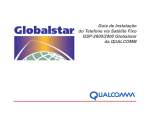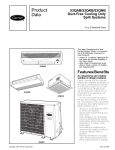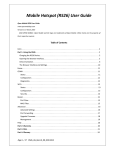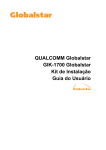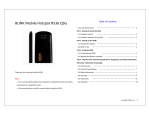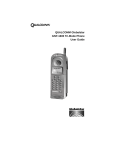Download Qualcomm GSP-2800 User's Manual
Transcript
Globalstar GSP-2800/2900 Fixed Satellite Phone User Guide Reception zone RAU (Mount RAU for clear view of sky and horizon) 10 10 Pole not supplied Telephone Inside Building Junction box (outside wall) 1 2 4 3 5 7 * 6 8 9 0 # RAU cable (outside line) 12V power supply Telephone cable (inside line) Power cable (inside line) Ground wire (outside line) Ground level Ground rod 052AB_1999Q This guide is based on a version of the QUALCOMM Globalstar GSP-2800/2900 Fixed Satellite Phone. QUALCOMM reserves the right to make changes in technical and product specifications without prior notice. QUALCOMM Incorporated 5775 Morehouse Drive, San Diego, CA 92121-1714 Document Number 80-25808-1EN Rev. A Model Number CKABS0001 Copyright 1999 QUALCOMM® Incorporated. All rights reserved. This technology was exported from the United States in accordance with the Export Administration Regulations. Diversion contrary to U.S. law prohibited. QUALCOMM® is a registered trademark of QUALCOMM Incorporated. Globalstar ™ is a trademark of Loral Qualcomm Satellite Services, Inc. All other trademarks are property of their respective owner. Printed in the United States of America. Contents Cautions and Warnings ...................................................vii Understanding Your Telephone ..................................... ix Introduction ........................................................................ 1 About the QGFSP .............................................................1 Using your telephone effectively ......................................2 Understanding the QGFSP Installation ........................ 3 What your installer does ..................................................4 Radio antenna unit (RAU) .........................................4 Junction box ...............................................................4 Power supply ..............................................................5 What you need to do .........................................................5 Select a telephone ......................................................5 Activate the QGFSP ...................................................6 Types of calling tones .......................................................7 Using Your QGFSP ............................................................. 9 Obtaining your telephone number ...................................9 Making a call ....................................................................9 Ending a call ...................................................................10 Receiving a call ...............................................................10 Troubleshooting ................................................................ 11 How to contact the service center ..................................13 Safety Issues ...................................................................... 15 Precautions .....................................................................15 Lightning protection .......................................................15 QGFSP components ........................................................15 Radio frequency energy ..................................................15 Compliance with regulations .........................................16 Glossary .............................................................................. 17 Index ...................................................................................... 1 iii iv List of Figures Telephone showing relevant user features .......................... ix A roof installation ...................................................................3 v vi Caution Any changes or modifications not expressly approved in this document could void your warranty for this equipment. Warning Do not operate the QUALCOMM Globalstar GSP-2800/2900 Fixed Satellite Phone (QGFSP) during an electrical storm. Do not allow anyone to install, use, or service any portion of the QGFSP during an electrical storm (thunderstorm). vii Cautions and Warnings Cautions and Warnings Cautions and Warnings viii Figure 1. Telephone showing relevant user features Refer to Figure 1 to obtain a better understanding of the various parts of your telephone. If your installation includes a telephone from QUALCOMM, the diagram should match your telephone. If you elected to purchase your own telephone, the features labeled in this diagram may appear differently, depending on the particular model. For more details, see the book that came with your telephone. ix Your Telephone Understanding Your Telephone Understanding Your Telephone x Congratulations on the purchase of your QUALCOMM Globalstar GSP-2800/2900 Fixed Satellite Phone! About the QGFSP The QUALCOMM Globalstar Fixed Satellite Phone (QGFSP) is easy to use, versatile, and dependable. It combines the ready availability of a two-wire telephone interface with the superior performance of a state-of-the-art digital wireless technology known as Code Division Multiple Access (CDMA), and the Globalstar system. Your QGFSP consists of the following: a radio antenna unit (RAU), a junction box that minimizes damage from lightning strikes, a power supply, a telephone, and assorted cabling. Note In this book, we call the complete unit, including your telephone, the QUALCOMM Globalstar Fixed Satellite Phone or QGFSP. When we talk about the QGFSP, we’re talking about your entire Globalstar installation, not just your telephone. These elements allow you to make and receive telephone calls using the Globalstar satellite system. The Globalstar system makes clear, high quality voice, data, and fax communications possible. Note Data and fax require network support. Please contact your service provider to see if these features are available in your area. The QGFSP equipment required to make and receive telephone calls over the Globalstar system must be installed and maintained by your service provider. The inside wiring may have been installed before you purchased the QGFSP. If not, you or your service provider need to prepare your building for telephone service. 1 Introduction Introduction Using your telephone effectively To obtain best results and optimum service from your telephone, follow these guidelines: ■ ■ Do not use the telephone if it appears to be damaged. Speak directly into the telephone’s mouthpiece. Note The outdoor components of the QGFSP (the RAU, junction box and cabling) are designed for outdoor use, and, if properly installed, will not be harmed by weather. The telephone and the power supply are designed for indoor use and should be sheltered from the weather. Warning Do not use the telephone during an electrical storm. Do not allow anyone to install, use, or service any portion of the QGFSP during an electrical storm. Caution Allow only authorized personnel to install or service the QGFSP components, such as the RAU, junction box, and power supply. Unauthorized installation or service can be dangerous and can invalidate the warranty. This caution does not apply to connecting the telephone to the jack provided for this purpose inside the building. Note If the telephone connected to the QGFSP has a button labeled “Flash” and the QGFSP does not have a call waiting, pressing the “Flash” button during a call may end your call. 2 Understanding the QGFSP Installation This section explains the installation of the components of the QGFSP and includes some detail about the installed equipment. QGFSP Installation RAU (Mount RAU for clear view of sky and horizon) Reception zone 10 10 Pole not supplied Telephone Inside Building Ground wire (outside line) RAU cable (outside line) 1 2 4 3 5 7 * 6 8 9 0 # 12V power supply Junction box (outside wall) Telephone cable (inside line) Power cable (inside line) Ground wire (outside line) Ground level Ground rod 051AB_1999Q Figure 2. A roof installation Figure 2 shows a typical QGFSP installation. Your service provider’s representative will install the RAU, junction box, power supply, and cabling. Your telephone and power supply should be located inside the building. 3 If you have problems with the QGFSP components, contact your service provider. When installation is complete, you will have one or more telephone jacks on the inside of your building. What your installer does Your service provider will perform the QGFSP installation and may supply a telephone as part of your QGFSP installation. Radio antenna unit (RAU) The RAU, which acts as a radio receiver and transmitter, connects the telephone with the Globalstar satellites. It is essential that the RAU antenna have a clear view of the sky and the horizon. See Figure 2. RAU 334AB_1999Q.eps Junction box The junction box connects outside cables to the inside wiring. It also receives power from your power supply and supplies power to the RAU. The junction box and the grounding rod minimize damage to the telephone from lightning strikes to the RAU and outdoor cabling. It is designed to help minimize personal injury in the event of a lightning strike. Junction box Note Hazardous energy may be present on the telephone during electrical storms. For this reason, do not use the telephone during electrical storms. 4 780AA_1999Q QGFSP Installation Power supply 553AB_1999Q The power supply is selected by the service provider and the installer based on the availability of power at your location. The power supply provides +12 volts to the junction box and RAU. QUALCOMM sells a power supply for use with the QGFSP. If you do not have a reliable source of AC power, your service provider may have elected to provide power by another means such as a solar panel system or a gas generator. QUALCOMM does not sell these alternative power systems. Please contact your service provider for details regarding them. Note Your installer will have equipped your installation with a power supply. The installation is described in detail in the QUALCOMM Globalstar GSP-2800/2900 Fixed Satellite Phone Installation Guide (80-98052-1). What you need to do If your service provider did not supply a telephone, you will need to purchase a commercially available two-wire telephone set. You can either purchase a qualified and tested telephone from QUALCOMM or you can choose one of your own. Select a telephone If you are selecting your own telephone, look for one that uses standard DTMF tones (industry standard tones), not pulses, for dialing. You must select a telephone that uses Tip and Ring. Your service provider may be able to direct you to a supplier. For optimal results, a telephone should have good voice quality. Sound quality is determined by the telephone itself, as well as by signal reception. Your service provider representative can ensure proper placement of components to obtain the best signal reception. Note You may need to try several telephones before you find one that offers good voice quality when used with the QGFSP. 5 You can connect one or more telephones to your QGFSP. When using several telephones, an individual telephone should be 0.5 to 1.5 REN (ringer equivalency number). The REN of the telephone is usually on the bottom of the telephone. Add the REN of all the telephones you intend to use. The total REN of all telephones that you connect to your telephone wiring must not exceed 5.0 REN. (You can discuss this requirement with your service provider.) Activate the QGFSP When the building was wired to permit telephone service via the QGFSP, jacks for the telephone were installed, or existing jacks may have been connected to the Globalstar QGFSP components. These jacks are connected by telephone wire to the junction box. If your installer did not plug the telephones into the jack, do so now. Note All of the phones at your installation will have the same number. You can place or receive only one call at a time. 6 QGFSP Installation Types of calling tones When you listen to the handset, you may hear any of the following tones: Tone Description Ring A ringing sound from your telephone announces an incoming call. Dial A steady tone indicates the phone is ready to use. Busy/ Reorder A tone advising that the call did not go through. This is because: ■ The number dialed is busy ■ No lines are available ■ You are not connected to Globalstar Service. Try the number again later. Intercept An alternating tone indicating that something is wrong with the call. Hang up and try the call again. Note: The actual tones heard may vary according to what is used by your service provider. 7 8 Using Your QGFSP The QGFSP acts like a conventional wireline telephone, with one exception: after you dial a number there is a pause, then the QGFSP will attempt to place the call. After you have dialed the number, you can press the # key to begin the call process without waiting for the pause to end. Note You should expect excellent sound quality from your QGFSP. However, sound quality is a function of both your telephone and the rest of the installed QGFSP components. If you have problems with poor audio quality, see the chapter on Troubleshooting. Obtaining your telephone number Making a call To place a call: 1. Pick up the telephone handset. 2. Listen for the dial tone. When you hear the dial tone, dial the telephone number. 3. After a silent pause, the number will be sent over the system. 4. To avoid the pause, dial the number, then press #. 9 Using Your QGFSP Your service provider should provide you with a telephone number. This is the number you give out to others so that they can call you. Ending a call To end a call (hang up) replace the handset in its cradle. Be sure the handset is seated properly in the cradle. Receiving a call When you have an incoming call, the telephones connected to the QGFSP will ring. To answer the call, pick up any handset and speak into it. Note If the person at the other end of the call hangs up, the call is ended. Note When placing a call, if you do not hear a dial tone after lifting the handset, see the chapter on Troubleshooting. 10 Troubleshooting If you are unable to make or receive a telephone call, please review the following list of possible causes and attempt to find the problem before you contact your service provider’s authorized service center. Solution No dial tone Lift the handset to your ear and listen. If you hear nothing, then: 1. Verify that your telephone was installed properly. 2. Verify that the telephone is plugged into the telephone jack. 3. Check visually to see that the RAU and antenna have not been damaged. 4. If steps 1 to 3 do not fix the problem, contact your service provider. Busy/Reorder tone 1. The party you are calling is on another call. 2. All system channels may be busy. Try to dial the number again in a few minutes. 3. The Globalstar telephone may not be listed with the service provider. To register, contact your service provider. Troubleshooting Problem 11 Problem Solution Busy/Reorder tone (cont.) 4. The antenna or other QGFSP components may be broken or damaged. Weather conditions may be making phone transmission difficult. Contact your service provider. 5. Your unit may have power, but not be able to connect with the Globalstar system. Contact your service provider. Phone number dialed, but did not go through 1. Check the telephone number. You may have misdialed or dialed incorrect numbers. 2. The telephone you are dialing may be busy. Phone does not ring 1. You may have connected too many telephones. 2. Check the ringer volume switch (if your phone has one) and set it to ring louder. 3. Verify that the telephone is set to tone, not pulse. 4. Be sure your telephone is plugged into the jack correctly. Sound volume is too low Another telephone in your building may be off the hook. Hang up the extension. Poor reception Check the telephone wiring inside your building. Worn or poor quality telephone wiring may need to be replaced. Dial tone in middle of call The call has been lost. Hang up, then dial again and attempt to reestablish the call. 12 Solution No response Your phone cannot contact the satellite. Check the location of your QGFSP antenna. The antenna must have a clear view of the sky and the horizon. If this is not true, that is, if there are obstructions to the antenna’s view, call your service provider. You can remove the obstruction if it is safe to do so. Troubleshooting Problem If your power supply is equipped with a backup battery, check to see if the battery has grown weak or failed. You may need to replace the backup battery. Your service provider can supply you with a new battery, if necessary. Note: If your telephone is working, you should always hear a tone of some type when you lift the handset. Note: The actual tones heard may vary according to what is used by your service provider. How to contact the service center Contact your service provider and ask if there is a special telephone number for service. 13 14 Safety Issues This section describes the safety issues related to using your QGFSP, and explains how to avoid dangerous conditions. Precautions When using your QGFSP, follow these basic safety precautions: 1. Do not use your telephone near water; do not use the telephone near the bathtub, sink, wet basement, or a swimming pool. 2. Avoid using the telephone during an electrical storm. 3. Do not use the telephone to report a gas leak while in the vicinity of the gas leak. 4. Do not use the telephone when someone is within 3 meters (10 feet) of the antenna. Lightning protection While the QGFSP includes grounding and circuitry to protect equipment, facilities, and personnel from nearby lightning, lightning is a highly unpredictable and dangerous phenomenon. It is impossible to completely protect equipment and personnel from lightning. Do not use the telephone during a thunderstorm, except for brief calls in an emergency. QGFSP components The QGFSP components of your installation must be installed and repaired by a qualified technician sent by your service provider. Do not attempt to repair these components yourself. Radio frequency energy Your QGFSP incorporates a radio transmitter, receiver, and antenna (the RAU) that receive and send radio frequency (RF) energy. Maintaining a minimum line-of-sight separation distance of 35 cm (14 inches) between the transmitting antenna and all 15 Safety Issues The QUALCOMM Globalstar RF unit used with the phone is designed to comply with established ANSI, FCC, and international safety standards for safe levels of human exposure to RF energy. Nonetheless, RF field intensity at the surface of the transmitting Globalstar antenna is fairly high. personnel will ensure that the General Population/ Uncontrolled Exposure maximum permissible exposure (MPE) limits are not exceeded. This satisfies the MPE limits mandated by the FCC in 47 CFR Ch. 1 (10-1-98 Edition), Part 1, §1.1310 and defined in the ANSI/IEEE C95.1-1992 standard, and also satisfies the slightly more stringent European and international exposure limit recommendations by IRPA (1991) and ICNIRP (1996). Compliance with regulations Your QGFSP components comply with the following standards: ■ NCRP Report 86 (1986) National Council on Radiation Protection and Measurements ■ FCC Radio Frequency Radiation Exposure Limits, 47 CFR Ch. 1 (10-1-98 Edition) Part 1,§1.1310 ANSI/IEEE C95.1-1992 Standard, American National Standards Institute IRPA (1991) Guidelines on Protection Against Non-Ionizing Radiation, International Radiation Protection Association ICNIRP (1996), International Commission on Non-Ionizing Radiation Protection ■ ■ ■ 16 Term Explanation DTMF Dual-Tone Modulated Frequency. DTMF sets the standard for the frequency and sound of the tones you hear when you dial. FCC Federal Communications Commission (U.S.) Globalstar The satellite system over which your telephone operates. Handset The part of your telephone that you listen to and speak into. Hang up To replace the handset in the cradle of the telephone. Jack A receptacle that connects your telephone to the rest of your Globalstar components. It is installed by your service provider. Junction box The interface between outdoor cabling and indoor telephone wiring. Minimizes lightning damage when properly grounded. QGFSP QUALCOMM Globalstar Fixed Satellite Phone. The QGFSP includes the RAU, junction box, power supply, telephone, and all cabling. RAU Radio antenna unit. The RAU is a receiver, transmitter, and antenna for your satellite telephone. 17 Glossary Glossary Term Explanation REN Ringer equivalency number. A number that identifies the telephone as being FCC approved and ready to be used on a telephone network. RF Radio frequency RJ-11 jack A single line, two-wire receptacle for transmitting and receiving phone signals. 18 A about CDMA 1 QGFSP activating 6 installation 3, 15 outdoor components 3 1 C call ending a 10 placing a 9 receiving a 10 calling tones 7 CDMA 1 D DTMF 17 F FCC 17 G Globalstar 17 H handset 17 hang up 17 how to activate the QGFSP 6 contact service provider 13 end a call 10 place a call 9 receive a call 10 I icons caution vii warning vii J jacks 4, 17 junction box 4, 17 P placing a call 9 power supply 5 Q QGFSP 1, 17 R radio frequency 15 RAU 4, 17 receiving a call 10 regulation compliance 16 REN 18 RF 18 RJ-11 jacks 18 S safety 15 lightning protection 15 precautions 15 QGFSP components 15 selecting a phone 5 service provider 13 sound quality 9 T telephone number obtaining 9 tones busy/recorder 7 dial 7 intercept 7 ring 7 troubleshooting busy recorder tone 12 dial tone in call 12 making calls 11 no connection 12 no dial tone 11 phone does not ring 12 possible problems 11 receiving calls 11 reception 12 volume low 12 U using phone 2, 9 Index-1 Index Index Index-2






























